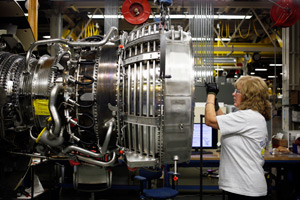Capital Goods Orders Rise for Second Time This Year

Orders for business equipment rose in May for just the second time this year, indicating demand for American-made manufactured goods is stabilizing.
Bookings for nonmilitary capital goods excluding aircraft rose 0.4% last month after a 0.3% decrease in April, data from the Commerce Department showed June 23. Orders for all durable goods — items meant to last at least three years — declined 1.8%, reflecting a drop in the volatile aircraft category.
The data indicate the worst of the slump in business investment in the oil patch may be over as fuel costs steady, which would alleviate a source of weakness for the economy. Exports probably will take longer to rebound as the dollar’s appreciation makes American-made goods less competitive globally.
It’s “a welcome shift after recent declines,” said Guy LeBas, chief fixed-income strategist at Janney Montgomery Scott in Philadelphia, who correctly forecast the increase in capital goods orders. “So long as energy prices remain reasonably stable and the dollar doesn’t appreciate too much more dramatically, we’ll see core durable goods orders trend back.”
The median forecast of 77 economists surveyed by Bloomberg News estimated total durable goods orders would fall 1%, with projections ranging from a 3.5% drop to a 2.6% increase.
Orders for nondefense capital goods excluding aircraft, a proxy for future business investment, were projected to rise 0.5%.
Shipments of such goods, which are used to calculate gross domestic product, increased 0.3% in May for a second month.
A pickup in business investment would go a long way toward boosting growth in the world’s largest economy, which suffered a setback in the first quarter amid harsh winter weather, a strong dollar and delays at ports.
GDP shrank at a 0.7% annualized rate, according to Commerce Department figures issued last month. The third and final estimate of first-quarter growth is scheduled for release June 24, with economists surveyed by Bloomberg News expecting growth to be revised to show a 0.2% drop.
Business investment excluding residential real estate declined at a 2.8% rate in the first quarter as spending on mines, shafts and wells plunged almost 49% as companies sought to balance supply and demand amid a global oil glut.
A slump in exports after the dollar jumped in the second half of last year subtracted a percentage point from growth.
Demand for new autos is one thing buoying production as Americans replace their vehicles. Industry data from Ward’s Automotive Group issued earlier this month showed cars and light trucks sold at a 17.7 million annualized rate in May, the strongest pace since July 2005.
Commercial aircraft orders dropped 35.3% in May after falling 10.7% a month earlier.
Boeing Co., the Chicago-based aerospace company, said it received 11 orders for planes last month, the fewest since January. Industry data do not always correlate with the government statistics on a month-to-month basis.
Excluding transportation equipment, which often swings from month to month, bookings increased 0.5%, the report showed.
A decline in inventories was one source of weakness in the Commerce Department report. Stockpiles fell 0.2% in May, the most in two years. That may prompt some economists to cut second-quarter growth estimates.
Gains in housing probably are helping to compensate for the slump in oil and gas drilling and in exports.
Faster household formation and low mortgage rates are boosting home sales and construction. That has companies such as truck maker Navistar International Corp. optimistic better demand for its products, including medium-duty trucks, will follow.
“We’re seeing growth in this important segment in 2015 due to increasing business investment and expansion in the housing market,” CEO Troy Clarke said in a June 4 conference call to discuss earnings. “Improving freight rates, lower energy costs, favorable business conditions, aging fleets, and better new truck fuel economy and safety, all translate into good demand for trucks.”

